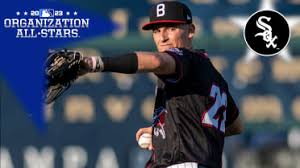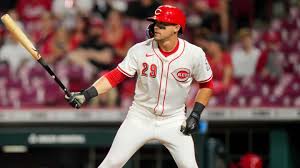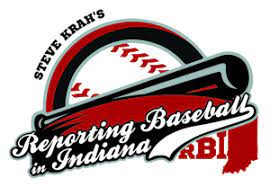Baseball America is a sports enterprise that covers baseball at every level, including MLB, with a particular focus on up-and-coming players in the minors, college, high school, and international leagues. It is currently published in the form of an editorial and stats website, a monthly magazine, a podcast network, and three annual reference book titles. It also regularly produces lists of the top prospects in the sport, and covers aspects of the game from a scouting and player-development point of view. Industry insiders look to BA for its expertise and insights related to annual and future MLB Drafts classes.
Recently, Baseball America produced a list of the top prospect at each position throughout the minor leagues. Two former Indiana high school players are on the rankings list. Max Clark of the Detroit Tigers (from Franklin Community High School) and Colson Montgomery of the Chicago White Sox (from Southridge High School) are on the list.

Colson Montgomery - Birmingham Barons (2023-AA) Chicago White Sox
Colson finds himself ranked 4th overall in the Top 25 of all minor league Shortstops
Listed are his graded out numbers for Hit/Power/Run/Field/Arm/Risk
Click below for the link to his ranking and grades
https://www.baseballamerica.com/stories/top-25-mlb-shortstop-prospects-entering-2024/
Max Clark - Lakeland Flying Tigers (2023- Rookie) Detroit Tigers
Max finds himself ranked 6th overall in the Top 10 of all minor league Center Fielders
Listed are his graded out numbers for Hit/Power/Run/Field/Arm/Risk
Click below for the link to his ranking and grades
https://www.baseballamerica.com/stories/top-10-mlb-center-field-prospects-entering-2024/

Explaining The 20-80 Baseball Scouting Scale
For the Baseball America Prospect Handbook, BA authors speak to hundreds of scouts over the course of the year to report on prospects and write the scouting reports enclosed. While none of the authors is a scout, we use scouts’ terminology to accurately report how the industry views and projects players. This includes the 20-80 scouting scale, the industry standard for grading players and their tools.
Many of these grades are measurable data, such as fastball velocity and speed (usually timed from home to first or in workouts over 60 yards). A fastball grade doesn’t stem solely from its velocity—command and life are crucial elements as well. A 100 mph fastball with poor movement characteristics may grade below a 97 mph fastball with elite movement. Secondary pitches are graded in a similar fashion. The more swings and misses a pitch induces from hitters and the sharper the bite of the movement, the better the grade.
Velocity steadily has increased over the past two decades. Not long ago, an 88-91 mph fastball was considered major league average. Now, major league starting pitchers sit 93 mph on average. You can reduce the scale by 1 mph for lefthanders, whose velocities are usually slightly lower. Fastballs earn their grades based on the average range of the pitch over the course of a typical outing, not their peak velocity.
A move to the bullpen complicates in another direction. Pitchers airing it out for one inning should throw harder than someone trying to last six or seven innings, so add 1-2 mph for relievers.
Hitting ability is as much a skill as it is a tool, but the physical elements of hand-eye coordination, swing mechanics and bat speed are key factors in how it is graded. Raw power generally is measured by how far a player can hit the ball, but game power is graded by how many home runs the hitter projects to hit in the majors, preferably an average over the course of a career. We have tweaked our power grades based on the recent rise in home run rates to reflect changing industry standards.
Arm strength can be evaluated by observing the velocity and carry of throws, measured in workouts with radar guns or measured in games for catchers with pop times—the time it takes from the pop of the ball in the catcher’s mitt to the pop of the ball in the fielder’s glove at second base. Defense takes different factors into account by position but starts with proper footwork and technique, incorporates physical attributes such as hands, short-area quickness and fluid actions, then adds subtle skills such as instincts and anticipation.
Not every team uses the wording below. Some use a 2-to-8 scale without half-grades, and others use above-average and plus synonymously.
For the Handbook, consider this BA’s 20-80 scale:
20: As bad as it gets for a big leaguer. Think Myles Straw’s power or Daniel Vogelbach’s speed.
30: Poor, but not unplayable, such as Kyle Hendricks’ fastball.
40: Below-average, such as Rafael Devers’ defense or Dylan Cease’s control.
45: Fringe-average. Matt Chapman’s hitting ability and Mike Zunino’s arm qualify.
50: Major league average. Jeff McNeil’s speed.
55: Above-average. Randy Arozarena’s power.
60: Plus. Marcus Semien’s defense or Zac Gallen’s control.
70: Plus-Plus. Among the best tools in the game, such as Freddie Freeman’s hitting ability, Blake Snell’s curveball and Ronald Acuña Jr.’s arm.
80: Top of the scale. Some scouts consider only one player’s tool in all of the major leagues to be an 80. Think of Shohei Ohtani’s power, Corbin Carroll’s speed or Devin Williams’ changeup.






